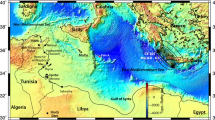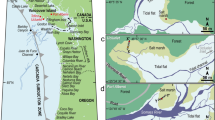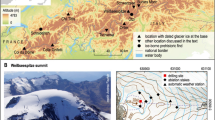Abstract
KELLAWAY has postulated1 an ice stream of Wolstonian (Saale) age moving from the Bristol Channel, across the lowlands of Somerset and into Wiltshire. He suggested that erratic rocks, including the “bluestones” from the Prescelly Hills of Pembrokeshire, subsequently erected in the Stonehenge monument, were carried into the chalk upland by this, or the earlier Anglian, ice sheet. At least one piece of the evidence he cites to support this hypothesis can be subjected immediately to critical examination. Kellaway described the Burtle Beds of Somerset in the following terms: “Other residual masses of glacial sand and gravel (‘Burtle Beds’) rise out of the marshes at Catcott Burtle, Weston Zoyland and Othery”. Their marine origin is cursorily dismissed in the phrase “These outwash deposits, previously thought of as marine....”. These deposits have, in fact, recently been the subject of detailed re-investigation2,3. This new work supports the conclusion by Bulleid and Jackson4,5 that the sands and gravels of the Burtle Beds are of marine origin. If that is the case then Kellaway's “glacial” hypothesis is much weakened. It is, therefore, important to review the grounds for re-asserting the marine character of the Burtle Beds.
This is a preview of subscription content, access via your institution
Access options
Subscribe to this journal
Receive 51 print issues and online access
$199.00 per year
only $3.90 per issue
Buy this article
- Purchase on Springer Link
- Instant access to full article PDF
Prices may be subject to local taxes which are calculated during checkout
Similar content being viewed by others
References
Kellaway, G. A., Nature, 233, 30 (1971).
Kidson, C., Proc. Ussher Soc., 2, 189 (1970).
Kidson, C., in Exeter Essays in Geography (edit. by Gregory, K. J., and Ravenhill, W.), 1 (Exeter, 1971).
Bulleid, A., and Jackson, J. W., Proc. Somerset Arch. and Nat. Hist. Soc., 83, 171 (1937).
Bulleid, A., and Jackson, J. W., Proc. Somerset Arch. and Nat. Hist. Soc., 83, 111 (1941).
Welch, F. B. A., Proc. Speleol. Soc. Univ. Bristol, 7, 137 (1955).
ApSimon, A. M., and Donovan, D. T., Proc. Speleol. Soc., Univ. Bristol, 7, 129 (1956).
Hawkins, A. B., and Kellaway, G. A., Proc. Geol. Assoc., 82, 267 (1971).
Prestwich, J., Quart. J. Geol. Soc. Lond., 48, 263 (1892).
Colhoun, E. A., and Mitchell, G. F., Proc. Roy. Irish Acad., 71, B, 211 (1971).
Whatley, R. C., and Kaye, P., in Oertli, H. J., Colloque sur la Paléoécologie des Ostracodes, 311 (SNPA, France, 1971).
Author information
Authors and Affiliations
Rights and permissions
About this article
Cite this article
KIDSON, C., HAYNES, J. Glaciation in the Somerset Levels: the Evidence of the Burtle Beds. Nature 239, 390–392 (1972). https://doi.org/10.1038/239390a0
Received:
Revised:
Issue Date:
DOI: https://doi.org/10.1038/239390a0
This article is cited by
-
The Burtle Beds of Somerset—glacial or marine?
Nature (1974)
-
“Burtle Clay” of Somerset
Nature (1973)
Comments
By submitting a comment you agree to abide by our Terms and Community Guidelines. If you find something abusive or that does not comply with our terms or guidelines please flag it as inappropriate.



